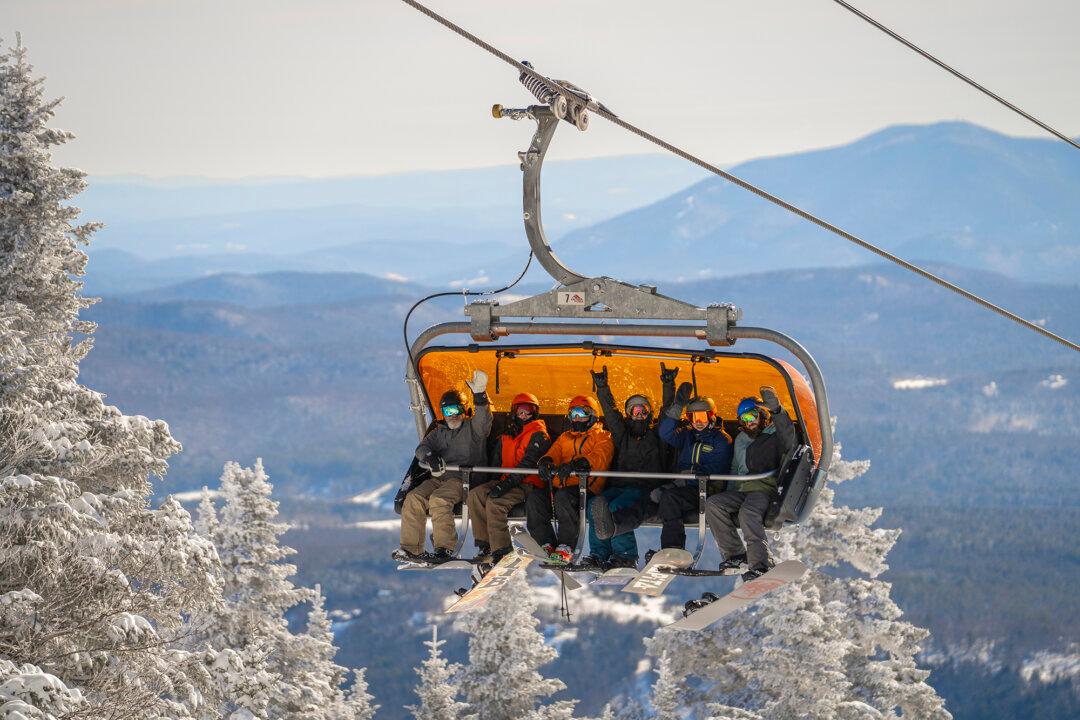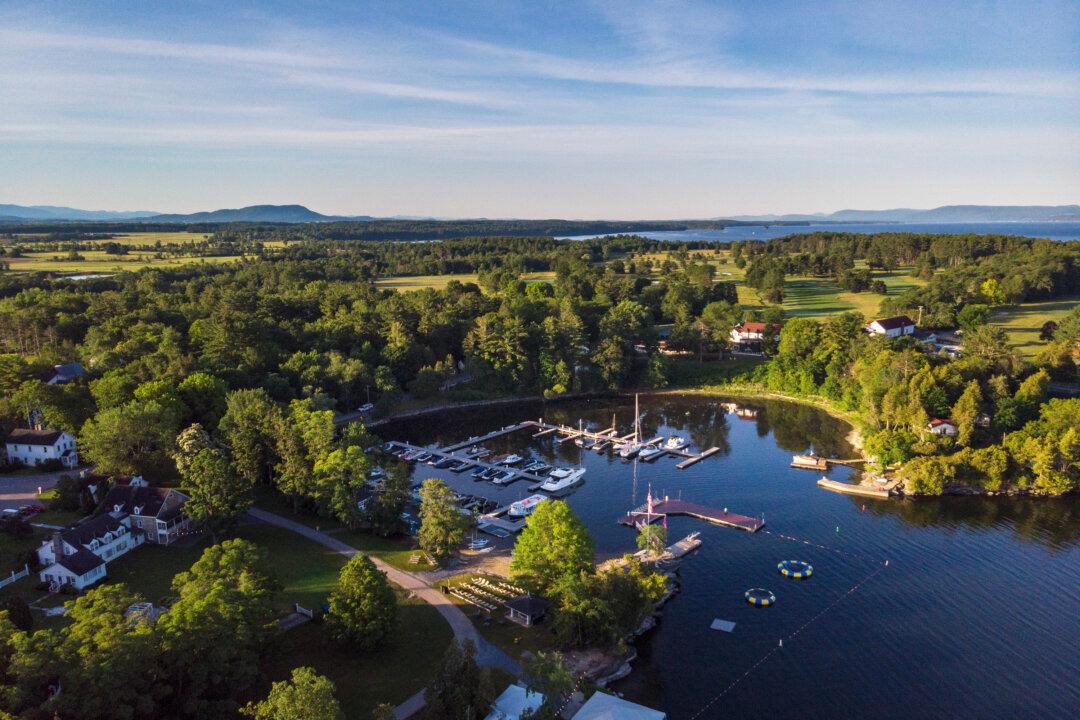On a blue-sky summer afternoon, we cruised through the quaint town, passed the covered bridge, and approached the historic Woodstock Inn’s long driveway. A surreal feeling set in as we parked on the red brick landing near the front porch’s white columns, above which sat a giant golden eagle statue.
We were transported to a bygone era upon entering the lobby, as if we were co-stars on the silver screen, expecting Cary Grant, Humphrey Bogart, and Katharine Hepburn to be sipping cocktails at one of the cozy sitting areas. The Victorian furnishings, décor, and oil paintings of pastoral Vermont completed the scene.

Indeed, the Woodstock Inn’s charms are not captured by its 5-star hotel rating. It’s a place with 229 years of historical significance, and the blessings of a benefactor in Laurance Rockefeller, grandson of Standard Oil’s John Rockefeller, history’s wealthiest American (though now tied or slightly overtaken by Elon Musk).
Why did Laurance Rockefeller, a man of unlimited means, take an interest in this quirky town and its local inn?
As is often the case—for love.

1934
It was a notable year in the New England town of Woodstock. In the snowy winter, the nation’s first rope-tow would be installed, giving birth to a modern, industrial-powered ski era.Then in August, the town’s local heiress, Mary French Billings, would marry one of the world’s most eligible bachelors: Laurance Rockefeller.
A Home for a Conservationist
In 1951 after Mary’s mother passed away, the Rockefellers renovated the Billings’ mansion and made Woodstock their country home. They would retreat here with family and close friends to immerse in nature along the banks of the Ottauquechee River, take hikes on Mt. Tom, observe the practices on their working farm, enjoy their lush gardens, and ski in the winter.
Rockefeller would become the nation’s leader on conservation, advising every president from Eisenhower until his death. His practical approach combined the preservation of lands with an emphasis on public access so that the masses could enjoy and benefit from nature’s wonders.
He is quoted by the National Parks Service, saying, “Concern for the environment and access to parks is not frivolous or peripheral; rather, it is central to the welfare of people—body, mind, and spirit.”
Rockefeller invested his time in many projects to establish public parklands in Wyoming, California, the Virgin Islands, Vermont, Maine, Hawaii, and New York. He also invested his private capital into creating a new kind of hospitality category called “eco-tourism,” which was aptly named RockResorts.

The keeper of the Woodstock Inn, which was located merely a few blocks from his own home, approached Rockefeller in 1967 about an investment into the tired property. It was determined that the Inn’s historical treasures should be preserved, but that the hotel’s structure needed to be completely rebuilt to restore its grandeur. Rockefeller took ownership of the hotel into his RockResorts portfolio, and the following year opened a new and vastly improved facility while maintaining the style and character of the original property. He went on to even have the town’s power lines placed underground in a beautification effort.
Experiencing Woodstock and the Inn
While many resorts of this caliber exist behind secure gates isolated from the surrounding community, the town of Woodstock and the Inn seem to effortlessly blend into each other with no discernible line of demarcation, as if they’re all part of the same quaint experience.
We would take walks around the Inn’s grounds and find ourselves drifting into town, stopping for a picture on the covered bridge, admiring the Victorian homes in the residential neighborhoods, exploring different spots along the river, and browsing the shops for gifts, books, and yummy treats.
Despite being a grand hotel, the Inn is Vermont casual. It was most welcoming to our children, who made full use of the old-timey parlor game room, explored the gift shop, and were treated to afternoon cookies in the lobby. Our dog, Sophie, was also treated with cookies at the front desk, and with a dog bed and bowl in our room.

The concierge was most happy to help us choose from the myriad of activities within the resorts’ ownership and in the surrounding area. My son and I enjoyed an epic round of golf on the celebrated Robert Trent Jones Sr. designed course.
After various morning excursions, we would spend our afternoons on chaise lounges by the heated saltwater pool enjoying the Vermont sun and building an appetite for dinner. We’d also spend time playing ball or walking Sophie on the Inn’s back lawn and roasting s’mores in the evening at the firepit.
Frequently, we would see fly fishing lessons underway on the lawn by the Activity Center, which also hosts a fleet of cruiser and mountain bikes ready to be fitted to families for exploring the streets and trails on two wheels. In the winter, it’s all about the Inn’s owned and operated ski resort, which is less than a 10-minute drive.

The Billings Farm and Mansion
For guests of the hotel, admission to the nearby Billings Farm Museum is at no cost, and I highly recommend it. There, a theater plays an Academy Award-nominated short documentary, “A Place on the Land,” which gives a fascinating introduction to the Billings Farm & Museum and the adjoining Marsh-Billings-Rockefeller National Historical Park.The film explores the 150-year history of the farm through the stewardship of George Perkins Marsh, who built the estate, Frederick Billings, who would pass on the estate through three generations of Billings women, to finally Mary and Laurance Rockefeller. Rather than pass it on to their children, the Rockefellers donated both the mansion and adjoining farm to the community upon Mary’s passing.
After watching the film, we toured the farmlands and indoor exhibits of all the old farming equipment, many of which were innovated on site, and then we walked across the road to tour the Billings Mansion.

As you walk through the home, you see all their original art, furniture, and even periodicals on the coffee tables as if it’s a space frozen in time. From the top floor windows, you can look out to the farm, gardens, mountains, the Inn, and the town of Woodstock and imagine escaping the busy New York City lifestyle and how this rural oasis would recharge their family.
If You Go
Arrive: You’ll need to arrive by car. Woodstock is near the intersection of Interstates 91 and 93 near the border of New Hampshire. Burlington Airport is about a 90-minute drive and Hartford and Boston Airports are within two and a half hours.






